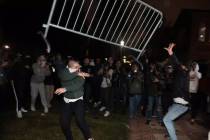Electricity finally arrives for Navajo family in southern Utah
FLAGSTAFF, Ariz. — For years, Thomas and Annie Hamm walked around their southern Utah home with flashlights at night, heated water on a wood burning stove and kept their food cold on ice.
Sometimes, they ran an extension cord from a car battery to power a television. They had a small solar panel installed to provide power but ran out of it whenever clouds rolled in.
This year, the couple finally has gotten electricity just in time for the holidays. They are planning a Thanksgiving dinner with their three sons and their families, including several grandchildren, that won’t have to end when the sun goes down.
“Now they’re coming no matter what time,” Annie Hamm said.
The Navajo Tribal Utility Authority recently brought power to the Hamms’ home in the tiny community of McCracken Mesa and plans to connect 240 other homes nearby. It’s part of a project to expand infrastructure in a desolate region of the country where basic services such as electricity, running water and telephone service are not available for thousands of people on the reservation that extends into Utah, New Mexico and Arizona.
For the Hamms, years of not having electricity were even more frustrating because they live less than one mile from an existing power line. Another utility company required Navajo families to pay much of the cost to extend the lines, and the Hamms couldn’t afford it.
Tribal utility aims to help poor
The Navajo Tribal Utility Authority bought a system of rural Utah substations and electrical lines last December under a decades-old deal with the Rocky Mountain Power utility.
The tribal utility now is the sole power provider in the Utah portion of the Navajo Nation. It seeks outside funding for easements, biological and archaeological clearances, environmental reviews and other surveys, lifting the financial and bureaucratic burden for tribal members, the utility said. Hooking up a single home can cost up to $50,000, the utility said.
“Our people’s per-capita income is $10,700 a year, there’s no way they can manage that,” said Walter Haase, general manager of the Navajo Tribal Utility Authority.
The lack of electricity on the Navajo Nation has long impacted residents: Children struggle to do homework at night, people with health problems can’t refrigerate medicine like insulin and water cannot be pumped into people’s taps. Economic development also suffers because businesses don’t want to invest in places without electricity.
Long wait for power
The Hamms raised their sons in a mobile home without electricity or running water and used kerosene lamps and flashlights to illuminate it. They moved into a new home in 2012 and had running water but only the shaky solar power for electricity.
Before the electrical line was installed at the house, they had to make frequent trips to the grocery store an hour’s drive away or to a gas station to buy ice to keep food cool when their small refrigerator powered by the solar panel was full. One holiday season, they put up their Christmas lights but the unreliability of the solar panel made it hard to keep the lights on.
“We couldn’t keep it on,” said Annie Hamm. “We’d plug it in for a while, then turn it off.”
Hamm, who is 60, kept track in a journal over the last two years the dates and times she called local officials and the tribal utility letting them know she was waiting for power.
Her count was 32, and she is convinced that her persistence and the home’s proximity to the existing power line put her near the top of the priority list for an electrical hookup.
“You have to stand up for yourself, you have to keep checking and checking,” said Hamm.
When electricity finally came to her house in late October, Hamm turned on all of its lights “to see what you can see.” Co-workers cheered her the next morning, and her family posted the news on social media.
One of her sons gave her a bigger refrigerator and she bought about $400 of food that would last about a month.
She’s been taking showers with hot water that flows straight from the pipes instead of water heated on the stove.
Her husband, Thomas, has been using power tools to build shelters for their pets. And she’s thinking about putting up the Christmas lights she has stored away.
“Those icicles,” she says. “I have a lot.”





























